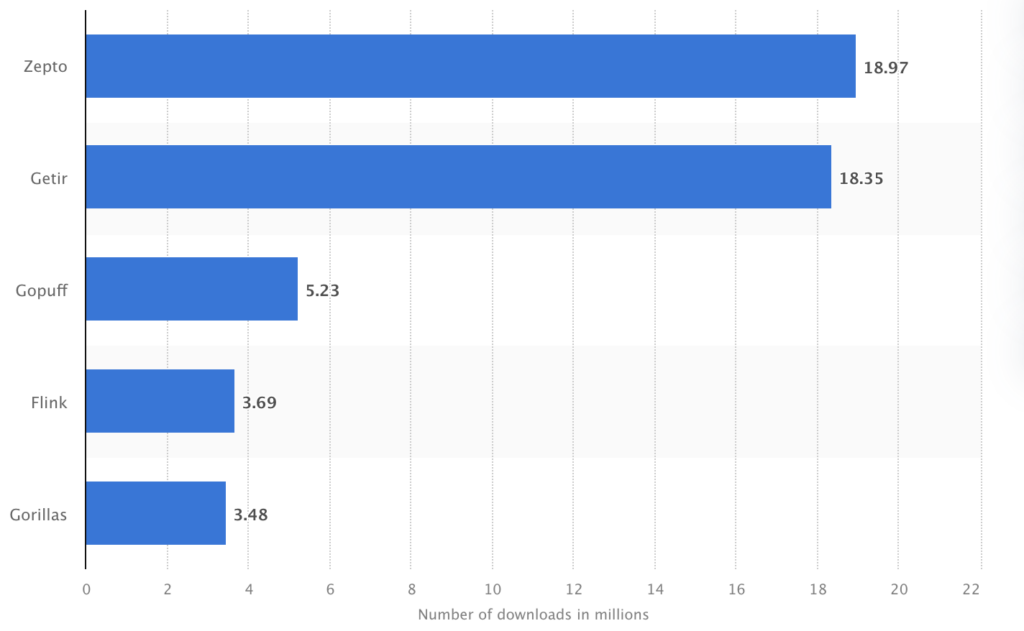In this fast-paced world, consumers are constantly seeking convenience and efficiency in shopping. This birthed Quick Commerce, a revolutionary concept that provides ultra-fast delivery of goods and services.
One of the leading players in this space is Zepto, it provides seamless and speedy delivery services. Zepto is a leading Quick Commerce app offering a wide range of products, that include groceries, household essentials, electronics, and more.
In this blog post, we explore the cost of developing a quick commerce app like Zepto. Zepto operates by partnering with local stores and utilising their existing inventories, ensuring that customers have access to a vast selection of items.
Estimated Time, Cost & Features For App Development
| Type Of App | Timeline | Cost | Features |
| Simple app | 4-6 months | $40,000-$80,000 | Basic delivery functionality Limited selection of products Simple UI |
| Complex app | 6-10 months | $80,000-$150,000 | A wide selection of products Sophisticated UI Order from multiple stores Track orders in real-time Online payment |
| Highly complex app | 10-15 months | $150,000-$400,000 | Voice ordering or Augmented Reality Constantly evolving UI Integration of food delivery or ride-hailing Personalised recommendations |
Factors Influencing the Cost of Developing a Quick Commerce App
A. App development approach
- Native vs. cross-platform development: The choice between native and cross-platform development significantly impacts the cost of development.
- Choosing the right technology stack: The tech stack chosen for app development also influences costs. The availability of third-party libraries and plugins can affect development time and cost.
B. Design and user interface considerations
- User experience (UX) design: Creating a seamless and intuitive user experience is crucial. Investing in UX research, user testing, and prototyping enhances overall app experience and development cost too.
- User interface (UI) design: Visual design and aesthetics impacts the overall appeal and usability of an app. Custom UI design requires time and resources compared to pre-designed templates. The complexity of the design and the number of screens also affects the cost.
- Customisation and branding requirements: If the app demands extensive customisation or branding, this can add to the cost.
C. Development team and resources
- In-house development vs. outsourcing
- Skillset and expertise required for development.
D. Backend infrastructure and APIs
- Server requirements and hosting: Quick Commerce apps require a robust backend infrastructure to handle various functions. Server architecture, scalability requirements, and hosting options (cloud hosting, dedicated servers) impacts development and operational costs.
- Integration with third-party services (payment gateways, delivery services): Integration with third-party services like payment gateways, delivery services, and analytics tools enhances cost. Some services may have usage-based fees or require additional development.
Key features and functionalities of a Quick Commerce app
- Real-time inventory management: Quick Commerce apps like Zepto ensure that their product listings are constantly updated.
- Seamless user experience and interface: Quick Commerce apps prioritise user-friendly interfaces for easy navigation, product search, and order placement.
- Advanced order and delivery tracking: Customers can track the status of their orders in real-time.
- Integration with various payment gateways: Quick Commerce apps facilitate smooth transactions by integrating with multiple payment gateways.
- Personalised recommendations and marketing tools: Quick Commerce apps leverage customer data and machine learning algorithms to offer personalised product recommendations, promotions, and discounts, to ensure customer retention.
Customer App Features
| Feature | Details |
| Home Page | Customers can view a range of products and categories that are available |
| Product Listing | Products in each category are listed with necessary details |
| Switch Categories | Customers can switch and navigate through various categories without returning to the home page |
| Product Description | Detailed product descriptions are provided to assist the buying decision |
| Order Cart | Customers can check the cart for added products and the billing details |
| Picker Recommendations | Picker can recommend substitutes for unavailable products to customers |
| Chat | Customers can chat with the assigned picker in real-time |
| Product Availability | Product availability can be reviewed and notified during checking out |
| Track Order | Customers can track from order acceptance to driver arriving at location |
| Membership | Introduce membership option and offer special discounts to members |
Picker App Features
| Feature | Details |
| Home Page | A list of tabs are shown where orders and their stages are displayed |
| Order Details | The store gets notified with all the necessary details of every order |
| Assign Picker | After accepting the order, admin can assign a picker for the customer |
| Chat | After order is accepted, picker can chat with the customer in real-time |
| Picking stages | Picker can update the stages: “Not Picked”, “Picked”, “In Review” or “Removed” |
| Suggest Substitutes | Picker can suggest alternate products for the items that are unavailable |
| Order Label | Picker can generate and print the label for each order for drivers to scan |
| Order Pick-up | Customer is notified immediately once the order is ready for pickup |
Driver App Features
| Feature | Details |
| Assigned Orders | Drivers will receive notifications of new orders to either accept or reject |
| Multiple Deliveries | Drivers can update multiple deliveries as and when orders are delivered |
| Pickup Proof | Drivers have to scan QR codes as a proof for picking-up the right order |
| Delivery Tracking | Drivers can send real-time updates after they arrive to pick up the order |
| Proof Of Delivery | Proof of delivery is customer signature or snapshot of order delivery |
| Reattempt Delivery | Drivers are allowed to reattempt a delivery with a valid reason for the same |
Admin Console Features
| Feature | Details |
| Promo Codes | Promo codes can be setup and made available for customers or by distribution through affiliates |
| Inventory Management | Inventory specific to each dark store and SKUs can be managed by the admin |
| App Updates | Manage app update settings and ensure users install the latest version |
| SEO Management | Manage SEO to ensure mobile responsiveness and SEO friendliness with sitemap and slug generation |
| Financial Accounting | Track and manage earnings of each dark store and delivery person |
| Track Analytics | Track order analytics of each dark store to improve customer experience |

Estimating the Cost of Developing a Quick Commerce App like Zepto
The development time for a quick commerce app like Zepto can vary depending on the complexity of the app, the development team’s expertise, and the availability of resources.
Cost breakdown and components
- Design and prototyping: Designing is creating the user interface (UI) and user experience (UX) for an app. It involves wire-framing, creating mock-ups, and developing interactive prototypes to visualise the app’s look and feel. The cost hinges on the complexity of the design and number of screens.
- Frontend and backend development: Frontend development focuses on implementing the visual elements of the app using PLs like HTML, CSS, and JavaScript. Backend development involves building the server-side logic, database management, and API integrations. The cost depends on the size and complexity of the app, and the tech stack.
- Quality assurance and testing: This involves testing for functionality, usability, performance, and security. It includes manual and automated testing, bug fixing, and ensuring quality standards.
- Integration with external services and APIs: Integration with external services like payment gateways, inventory management systems, or geolocation APIs are necessary. The cost will depend on the number and complexity of the integrations.
- Deployment and ongoing maintenance: Deploying the app to the desired platforms. Ongoing maintenance includes bug fixes, updates, and server management.
Conclusion:
Quick Commerce, exemplified by apps like Zepto, is revolutionising the way consumers shop by prioritising speed, convenience, and seamless delivery. As the demand for instant gratification continues to grow, Quick Commerce is poised for significant expansion in the global retail landscape.
With its real-time inventory management, user-friendly interface, advanced tracking capabilities, seamless payment integration, and personalised marketing tools, Zepto exemplifies the key features and functionalities that make Quick Commerce apps successful.
As we embrace the future of on-demand shopping, Quick Commerce is set to redefine the boundaries of convenience and transform the way we fulfil our daily needs.

After an Engineering degree and a Diploma in Management I devoted 16+ years working in the automotive industry. My innate skill and extreme passion in writing, encouraged me to adopt it up as a profession. I have been writing for more than 10+ years in the software industry. The 400+ blogs I published are informative, exhaustive and interesting to a professional and causal reader.








